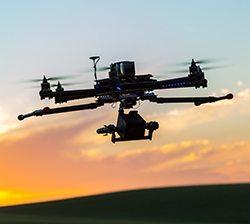Drones, GenAI and the Need for Collision Avoidance Communications Protocol
 It looks like delivery drones and air taxis are coming fast. As their numbers increase, low-altitude airspace is going to get congested. We need to find a way to avoid collisions. GenAI will likely
play a key role in autonomous operation. But, it is not sufficient by itself to prevent collisions. We need a protocol for collision avoidance. Research on this topic has not created a solution. Things are happening too fast to wait for a 6G solution.
The best way forward may be for those building the equipment and those planning to use the equipment to come together and develop such a protocol.
It looks like delivery drones and air taxis are coming fast. As their numbers increase, low-altitude airspace is going to get congested. We need to find a way to avoid collisions. GenAI will likely
play a key role in autonomous operation. But, it is not sufficient by itself to prevent collisions. We need a protocol for collision avoidance. Research on this topic has not created a solution. Things are happening too fast to wait for a 6G solution.
The best way forward may be for those building the equipment and those planning to use the equipment to come together and develop such a protocol.
Increasing Drone Deployments
Drone delivery has been talked about for years. What is different now is that it is beginning to happen in a way that could produce an explosion in traffic. For example, Zipline is launching its airborne delivery service in the Dallas-Fort Worth suburb of Mesquite and will spread to Seattle before the end of the year. Zipline has already flown over 1.4 million deliveries and covered over 100 million miles. Wing has completed more than 75,000 deliveries in the Dallas area. Flown more than 315,000 miles with an average flight time (from takeoff to delivery) of 3 minutes and 27 seconds. Amazon is starting a drone delivery in a Phoenix suburb. Walmart is starting a drone delivery in a Dallas suburbDeployment is also happening in other parts of the world, such as home delivery in Bengaluru, India. And, prompted by Zipline’s success in delivering medical supplies in Ghana, the UK National Health Service has started drone delivery of medical supplies in the UK.
Congestion Problem
It appears that drone delivery is well on its way, with average delivery times of three and a half minutes. If congestion problems are avoided, drone delivery may become ubiquitous. All major retailers may have to offer it.
One problem that could impede success is some highly publicized collisions. The coverage of the recent collision between a helicopter and an airliner in Washington, D.C., is an example of how
much negative attention a collision can create. As long as there is a very low density of activity in low air space, the probability of collision appears relatively low. But, of course,
successful drone businesses will generate much more traffic, dramatically increasing the likelihood of collisions.
Delivery drones are not the only things using low airspace. In addition to conventional aircraft, there will be air taxis. The first will be piloted ones, like the electric piloted air taxi service from and to all
three New York City airports or connecting the major cities in the San Francisco Bay Area. Autonomous air taxis are being produced. Examples include those in the US and China. Examples
of services outside the US include ones in India.
The Zipline-style drone adds another form of congestion. In delivery mode, the main aircraft hovers and drops a smaller powered craft tethered by a cable. This smaller craft goes to the ground
and drops off the package. One craft becomes two. The space between the two crafts is obstructed or occupied by the cable connecting them.
Given all this, we can foresee how low-altitude airspace will soon become congested.
Possible Collision Avoidance Solutions
The traditional way of avoiding collisions is using manual air traffic controllers. The growth of commercial airliner service is already stretching such manual systems to and beyond their limits. Commercial aircraft have collision avoidance systems that warn the pilot of an impending collision. When such a warning occurs, the pilot only has time for an extreme maneuver. In low-altitude airspace at climbing or landing speed, the plane may not be able to make such a maneuver.
In the short term, it is neither politically nor economically viable to try to replace legacy air traffic control systems. What is needed is a way for conventional legacy air traffic control
systems to continue while providing a way for an explosion in drone and air taxi traffic.
One approach that appears to have some support in the US is to treat drones and air taxis the same way as autonomous automobiles. Use GenAI and just keep them away from the areas surrounding
airports. That approach doesn’t seem to scale. The largest customer bases will be in the areas used for the takeoff and landing of commercial airliners in major metropolitan
areas. Also, the problem of collision avoidance in low altitudes is different and much more difficult than for automobiles. Surface vehicles operate in 2D (two-dimensional) spaces that are
well-defined by streets, roads, lane lines, stop signs, traffic lights, well-established required behaviors, with no or very few obstacles. Low-altitude vehicles operate in 3D spaces with
obstacles such as tall buildings, and without roads, lanes, stop signs, and traffic signals. Thus, it is hard to predict, even with the fastest and most effective GenAI, what another
low-altitude vehicle is going to do.



















